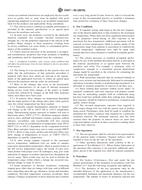Wir benötigen Ihre Einwilligung zur Verwendung der einzelnen Daten, damit Sie unter anderem Informationen zu Ihren Interessen einsehen können. Klicken Sie auf "OK", um Ihre Zustimmung zu erteilen.
ASTM C447-03(2010)
Standard Practice for Estimating the Maximum Use Temperature of Thermal Insulations
Automatische name übersetzung:
Standard Praxis zur Abschätzung der maximale Gebrauchstemperatur von Thermoisolierung
NORM herausgegeben am 1.11.2010
Informationen über die Norm:
Bezeichnung normen: ASTM C447-03(2010)
Anmerkung: UNGÜLTIG
Ausgabedatum normen: 1.11.2010
SKU: NS-13437
Zahl der Seiten: 3
Gewicht ca.: 9 g (0.02 Pfund)
Land: Amerikanische technische Norm
Kategorie: Technische Normen ASTM
Die Annotation des Normtextes ASTM C447-03(2010) :
Keywords:
hot surface performance, maximum use temperature, thermal insulation, Block and board thermal insulation, Maximum use temperature, Pipe thermal insulation, Soak testing, Temperature tests--thermal insulation, Thermal insulating materials, ICS Number Code 91.100.60 (Thermal and sound insulating materials)
Ergänzende Informationen
| Significance and Use | ||||||||||||||||||||||||||
|
This practice is intended for use as a guide in evaluating the behavior of insulations at elevated temperatures, and in judging suitability for use under the conditions of an intended application. It is not intended for acceptance or certification testing on a lot basis. No single test for estimating maximum use temperature can be used that will apply to all types of insulations, nor can any single maximum use temperature be applied to any insulation that will be applicable under all possible conditions of use. Maximum use temperature may depend on thickness, temperature gradient, heating rate, and other factors. When the various test methods listed herein are employed, the test results serve as guides and, as such, must be applied with good engineering judgment in arriving at an acceptable temperature limit for the products and applications being considered. The criteria used to establish acceptable performance is provided in the material specification or as agreed upon between the purchaser and seller. In most cases, the properties covered by the applicable material standards (for example, thermal transmission, strength, etc.) are the properties important to the end use of the product. Major changes in those properties resulting from in-service conditions can cause failure or substandard performance of the installed system. Unless removal and reuse of the insulation is an important consideration, properties that relate primarily to handling and installation shall be eliminated from the evaluation. Note 1—Installation assemblies: some systems create conditions that will affect the performance from the data obtained in the test procedures of this practice. The listing of a test procedure in this practice does not imply that the performance of that particular procedure is required. Only those tests which are relevant to the requirements of the application involved, or which are agreed upon between the purchaser and the seller are preformed. Most of the changes that occur in the functionally important characteristics of all types of thermal insulation during service result from changes in the matrix or binder system first, followed by changes in the bulk filler materials where such fillers have been used. In general, these changes are temperature-dependent and the major portion of the change takes place fairly quickly once the critical temperature has been reached. Typically, organic thermoplastic materials or binders will change in the 140 to 240°F (60 to 116°C) temperature range. Thermosetting organic materials or binders will start to deteriorate above 350°F (177°C). Hydrated inorganic binders such as clays, portland and lumnite cements, gypsum, sodium silicates, oxysulfates, and oxychlorides will lose varying amounts of water of crystallization at temperatures from 250 to 900°F (121 to 482°C) dependent on the compound involved. Glass fibers and glass foams may start to sinter around 1000°F (538°C). Rock or slag wools, perlites and refractory fibers may show change at temperatures in excess of 1300°F (704°C) dependent on specific composition. If, after testing samples exposed to the maximum service temperature, additional tests are made of samples exposed to intermediate temperatures (third or quarter points in the full service temperature range), the results of such tests, when plotted with proper curve fit techniques, may give some indication of changes in product characteristics throughout the service range. These results may also be used to bracket the temperature range within which a change has occurred (significant change in slope of curve). Some properties of thermal insulations containing trapped gases other than air change with time, and at different rates, depending upon the age, thickness, facing and boundary conditions. Elevated temperature exposure accelerates these changes. Changes in properties of these materials may continue over a very long period of time, however, and it is beyond the scope of this recommended practice to establish a minimum time period for evaluation of these long-term changes. |
||||||||||||||||||||||||||
| 1. Scope | ||||||||||||||||||||||||||
|
1.1 This practice covers estimation of the maximum use temperature of thermal insulation including loose fill, blanket, block, board, and preformed pipe insulation. It is based upon selected performance criteria, and characterization of product properties during and after use conditions. 1.2 The values stated in inch-pound units are to be regarded as standard. The values given in parentheses are mathematical conversions to SI units that are provided for information only and are not considered standard. 1.3 This standard does not purport to address all of the safety concerns, if any, associated with its use. It is the responsibility of the user of this standard to establish appropriate safety and health practices and determine the applicability of regulatory limitations prior to use. |
||||||||||||||||||||||||||
| 2. Referenced Documents | ||||||||||||||||||||||||||
|
Empfehlungen:
Aktualisierung der technischen Normen
Wollen Sie sich sicher sein, dass Sie nur die gültigen technischen Normen verwenden?
Wir bieten Ihnen eine Lösung, die Ihnen eine Monatsübersicht über die Aktualität der von Ihnen angewandten Normen sicher stellt.
Brauchen Sie mehr Informationen? Sehen Sie sich diese Seite an.




 Cookies
Cookies
